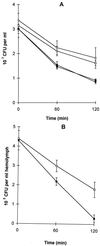Surface interactions between Escherichia coli and hemocytes of the Mediterranean mussel Mytilus galloprovincialis lam. leading to efficient bacterial clearance
- PMID: 11133482
- PMCID: PMC92602
- DOI: 10.1128/AEM.67.1.464-468.2001
Surface interactions between Escherichia coli and hemocytes of the Mediterranean mussel Mytilus galloprovincialis lam. leading to efficient bacterial clearance
Abstract
The role of type 1 fimbriae in the interactions between Escherichia coli and Mytilus galloprovincialis Lam. hemocytes was evaluated. The association of fimbriated strain MG155 with hemocyte monolayers at 18 degrees C was 1.5- and 3- to 4-fold greater than the association of unfimbriated mutant AAEC072 in artificial seawater and in hemolymph serum, respectively. Such differences were apparently due to different adhesive properties since MG155 adhered more efficiently than AAEC072 when hemocytes were incubated at 4 degrees C to inhibit the internalization process. Hemolymph serum increased both association and adherence of MG155 two- to threefold but did not affect association and adherence of AAEC072. MG155 was also 1.5- to 1.7-fold more sensitive to killing by hemocytes than AAEC072, as evaluated by the number of culturable bacteria after 60 and 120 min of incubation. The role of type 1 fimbriae in MG155 interactions with hemocytes was confirmed by the inhibitory effect of D-mannose. In in vivo experiments MG155 cells were cleared from circulating hemolymph more rapidly than AAEC072 cells were cleared. These results confirm that surface properties are crucial in influencing bacterial persistence and survival within mussel hemolymph.
Figures

References
-
- Anderson R S. Immunocompetence in invertebrates. In: Giam C S, Lee R E, editors. Pollutant studies in marine animals. Boca Raton, Fla: CRC Press; 1980. pp. 93–110.
-
- Birkbeck T H, Gallacher S. Interactions of pathogenic vibrios with marine bivalves. In: Guerrero R, Pedros-Aliò C, editors. Trends in microbial ecology. Barcelona, Spain: Spanish Society for Microbiology; 1993. pp. 221–226.
-
- Blomfield I C, Clain M S, Eisenstein B I. Type 1 fimbriae mutants of Escherichia coli K12: characterization of recognized afimbriated strains and construction of new mutants. Mol Microbiol. 1991;5:1439–1445. - PubMed
-
- Chen J H, Bayne C J. Bivalve mollusc hemocyte behaviours: characterization of hemocyte aggregation and adhesion and their inhibition in the California mussel (Mytilus californianus) Biol Bull (Woods Hole) 1995;188:255–266. - PubMed
-
- De Leon R, Jaykus L A. Detection of the presence of bacteria and viruses in shellfish. In: Hurst C J, Knudsen G R, McInerney M J, Stetzenbach L D, Walter M V, editors. Manual of environmental microbiology. Washington, D.C.: American Society for Microbiology; 1997. pp. 203–212.
Publication types
MeSH terms
LinkOut - more resources
Full Text Sources

